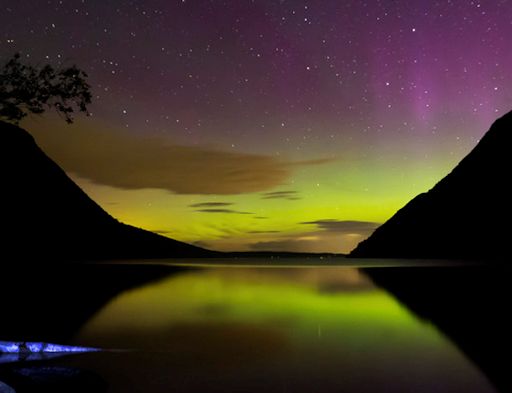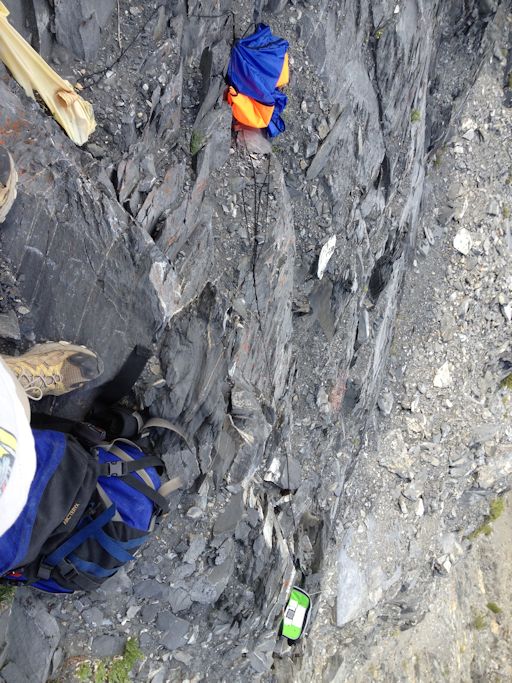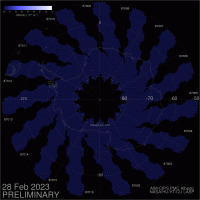A MARS ROVER'S IMPROBABLE ANNIVERSARY: When Opportunity left Earth on July 7, 2003, many observers expected the rover to survive no more than a few months on the hostile surface of Mars. Ten years later, Opportunity is still going strong and could be poised to make its biggest discoveries yet at a place named Solander Point. [video] [full story]
SHAPE-SHIFTING SUNSPOT: Behemoth sunspot AR1785 is undergoing a metamorphasis, changing shape by the hour as it turns toward Earth. This movie from NASA's Solar Dynamics Observatory shows the action on July 6-7:
In less than 24 hours, AR1785 has stretched and lengthened by more than 40,000 km. It is now more than 11 times as wide as Earth, which makes the active region an easy target for backyard solar telescopes.
One thing hasn't changed: the sprawling sunspot group has a 'beta-gamma-delta' magnetic field that harbors energy for strong solar flares. Moreover, the shape-shifting of AR1785 could lead to explosive instabilities in the sunspot's magnetic canopy. NOAA forecasters estimate a 55% chance of M-class solar flares and a 10% chance of X-flares during the next 24 hours. Solar flare alerts: text, voice.
Realtime Space Weather Photo Gallery
WEEKEND AURORAS: Auroras are a sign of geomagnetic storms. Sometimes they are a sign of no geomagnetic storms, too. On July 5-6, observers in Canada and upper-tier US states spotted auroras even though no storm was in progress. John Vose sends this picture from Lake Willoughby in northern Vermont:
"The clouds were lit by occasional lightning, and the rocks were illuminated with my cell phone," says Vose. It was a lucky shot because "soon after the auroras appeared, the fog rolled in...."
At the time, Earth was passing through a region of interplanetary space with a south-pointing magnetic field. The encounter opened a crack in Earth's magnetosphere; solar wind poured in to fuel the auroras. Despite the colorful lights, geomagnetic activity never crossed the threshold into full-fledged storming.
Actual storms could be in the offing, however. A solar wind stream is approaching Earth, due to arrive on July 7-8. NOAA forecasters estimate a 30% to 35% chance of polar geomagnetic storms. Aurora alerts: text, voice.
SPACE WEATHER BALLOON CLIFFHANGER: On July 2nd a recovery team reached the payload of a space weather balloon launched on June 30th. It was the second attempt to retrieve the balloon from its mountainous landing site in the Sierra Nevada mountains of central California. The first attempt late on July 1st was aborted due to challenging terrain and fading sunlight. This time, the team started earlier and in the full light of midday they found the landing site. It turned out to be a cliffhanger:
As shown above, the payload was dangling from a shear cliff face more than 1400 feet above the foot of the Nevahbe Ridge. Super-climber Michael White, a member of the Earth to Sky Calculus student group that launched the balloon, was able to reach the landing site and snag the payload from the safety of a small ledge just above the parachute. The shoe in the photo belongs to Michael.
This balloon was launched at the peak of a record-setting heat wave in the southwestern USA, bringing temperatures as high as 128 F to desert areas around the launch site. The goal of the curiosity-driven flight was to discover whether the heat wave extended all the up to the Edge of Space. To help answer the question, the balloon's payload was outfitted with two HD video cameras, a pair of GPS trackers, a GPS altimeter, a cryogenic thermometer and an ozone sensor.
Students are analyzing the footage and data now. Stay tuned for results!

Solar wind
speed: 290.9 km/sec
density: 6.5 protons/cm3
explanation | more data
Updated: Today at 1626 UT
X-ray Solar Flares
6-hr max: C1 1213 UT Jul07
24-hr: C6 0058 UT Jul07
explanation | more data
Updated: Today at: 1600 UT
![]()
Daily Sun: 07 July 13
Sunspot AR1785 has a beta-gamma-delta magnetic field that harbors energy for X-class solar flares. Credit: SDO/HMI
![]()
Sunspot number: 115
What is the sunspot number?
Updated 06 Jul 2013
Spotless Days
Current Stretch: 0 days
2013 total: 0 days (0%)
2012 total: 0 days (0%)
2011 total: 2 days (<1%)
2010 total: 51 days (14%)
2009 total: 260 days (71%)
Since 2004: 821 days
Typical Solar Min: 486 days
Update 06 Jul 2013
The Radio Sun
10.7 cm flux: 141 sfu
explanation | more data
Updated 06 Jul 2013
![]()
Current Auroral Oval:
Switch to: Europe, USA, New Zealand, Antarctica
Credit: NOAA/POES
![]()
Planetary K-index
Now: Kp= 1 quiet
24-hr max: Kp= 4 unsettled
explanation | more data
Interplanetary Mag. Field
Btotal: 4.0 nT
Bz: 3.9 nT north
explanation | more data
Updated: Today at 1627 UT
![]()
Coronal Holes: 07 Jul 13
Solar wind flowing from this coronal hole could reach Earth on July 6-8. Credit: SDO/AIA.
![]()
Spaceweather.com is now posting daily satellite images of noctilucent clouds (NLCs), which hover over Earth's poles at the edge of space. The data come from NASA's AIM spacecraft. The north polar "daisy" pictured below is a composite of near-realtime images from AIM assembled by researchers at the University of Colorado's Laboratory for Atmospheric and Space Physics (LASP). |
![]() Noctilucent Clouds
Noctilucent Clouds
Switch view: Europe, USA, Asia, Polar
Updated at: 07-06-2013 10:55:03








